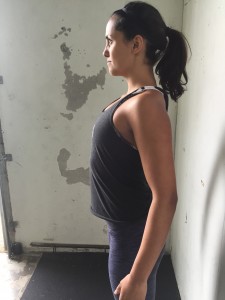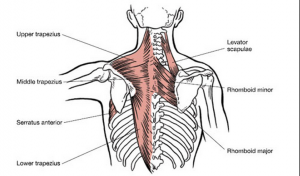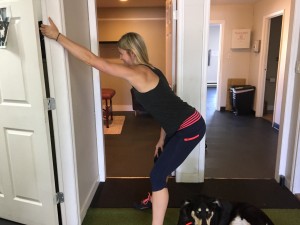When it comes to improving shoulder mobility, stability, strength and function (basically everything shoulder-related) it’s important to first understand the basics of how your shoulders operate, and why they’re pretty much the worst joint ever.
Your shoulder is actually more of complex comprised of two joints, the glenohumeral and the acromioclavicular joint.
What makes the shoulder unique is that in order for it to function properly it needs the scapulae to do the same—and in order for the scapulae to function properly you need to have support from several muscles that work to stabilize and produce its movement.
Another component that has to be considered when talking shoulders is the thoracic spine. If you don’t have a neutral curvature through your thoracic spine, your scapula will not be able to glide properly over the thorax during arm movements; which will have an effect on your scapulohumeral rhythm. Poor scapulohumeral rhythm limits your shoulder mobility, and can cause compensations to occur.
Here’s a quick video that nicely summarizes scapulohumeral rhythm.
Now that you have a basic understanding of how the shoulder operates, I’m sure you can appreciate why it’s not the easiest joint to keep happy. But I will stop boring you with anatomy and physiology lessons and move onto the stuff that you can actually apply. In other words, the good stuff.
Address the Issues Causing the Problem(s)
1. Faulty Breathing Patterns
If you’ve read any of our previous posts then you know that addressing breathing patterns is always a given when it comes to corrective work. What does breathing have to do with your shoulders? Well when you don’t utilize proper diaphragmatic breathing you tend to take shallow chest breaths—causing your shoulders to elevate with each breath. If you do this all day and you will successfully cause excessive tension in your neck muscles, not to mention cause an increase of dominance in the upper fibres of your trapezius muscles.
The other issue is hyperinflation. Most of us are stuck in a state of “hyperinflation.” This means that we are unable to get rid of stale air in the chest and our ribs are constantly in a flared position. See the image below for an example of what I mean by this.
Hyperinflation contributes to poor posture, as well as poor interaction of your diaphragm muscle and your abdominals. If these two muscles don’t interact, your inter-abdominal pressure is lowered, and the potential to brace with your core significantly decreases.
Read THIS post to learn more about how breathing can affect your training and posture, as well as how to fix it.
2. Posture
Addressing postural issues is a blog post in itself. But what I want to emphasize here is the importance of getting in the habit of setting a neutral posture before you carry out a movement. We have an advantage while strength training when it comes to posture, as you can literally set yourself into a perfect ready position before executing your desired movement. You can also re-set after each rep if you’re really picky about posture, like me. However we don’t have that same luxury when playing sports… and who thinks about shoulder positioning when reaching for a glass from the cupboard or doing up their seatbelt?
The best way to set neutral posture is to explore your max range, then find the mid-point. For the shoulder start with elevation and depression. Bring both shoulders up to your ears, then drop them down as far away from your ears as possible. Do that a couple times, then find the mid-point. Next, round your shoulders forward then retract them back. Again, find the mid-point. Once you’ve done this a few times you will build the kinesthetic awareness of where you neutral shoulder position lies.
You can use this technique prior to completing any arm-based exercise, but I definitely recommend it prior to standing rows and pressing variations.
3. Lack of stability
Poor scapular stability is the biggest culprit of poor shoulder mechanics. The most common muscular imbalance we see is over developed upper traps in conjunction with weak mid and lower traps, as well as serratus anterior muscles.
This imbalance is commonly found on those who also have rounded shoulders, a slightly head forwards posture, and tight pecs and lats. This type of posture isn’t just less than pretty…
It will also have a detrimental effect on how your body moves. If you don’t attend to your postural issues or imbalances your body will compensate—and trust me when I say that you don’t want that to happen. Poor posture, weak scapular stabilizers, and restrictions in your overall shoulder movement will lead to a shoulder injury at some point; usually to one of your rotator cuff muscles and/or your biceps tendons. It will also keep you from reaching your full potential when it comes to building your upper body strength.
The good news? You can fix it.
Here’s how.
First address the soft tissue.
Use a lacrosse ball to loosen up your—
Upper Traps
Pecs & Lats
Foam roll you thoracic spine
Then complete mobility drills.
Stretch you lats
Lengthen your pecs
Mobilize your thoracic spine
Next, activate your stabilizers.
Supine No Money Drill
Wall slides
Then comes your strength work…
Overhead work is great, if you have the mobility for it. Being strong overhead can help bulletproof your shoulders. However, you need to start with a good platform. If you choose to include overhead work in workout your program, you need to make sure that you have the shoulder mechanics discussed above prior to loading your overhead movement(s) with weight.
More often than not this is what most people’s shoulders look like when they go into a full shoulder flexion. Notice how the scapulae elevates more than they upwardly rotate.
This is what they should look like.
As I’m sure you can now see, addressing scapular instability is essential to improving shoulder mechanics.
Another key component is core strength—because you need to have stable foundation in order to press off of it well. This is where your anterior core and glutes come into play; both for pelvic control and for controlling your rib position. To learn more about how you can affectively target your anterior core, read THIS post.
Here are 3 exercises that will help ensure you keep your core set while completing overhead work.
Supine Pullovers
½ Kneel Shoulder Press
Tall Kneeling Pressing Variations
4. Pull More Than You Press
Lack of balance with programming is a common error that people make; specifically with the amount of pressing vs. pulling that is completed.
In general I recommend to do 2-3 pulling based exercises for every 1 pressing exercise that you do. Your pulling variations can be rows, pull up variations, lat pulls, or any other exercise that targets the back of your shoulder and/or your upper back.
Row’s are an exercise that I constantly see done poorly. When you perform a row you need to start with a neutral position, and ensure that you’re coming in to scapular retraction in addition to shoulder extension.
Watch this video to see what I am talking about.
5. Mix Up Your Presses
All of the following will help encourage better scapular movement, stability, and shoulder function.
Doing pressing patterns where the scapula isn’t fixed. I’m not knocking the bench press when I say this— it’s an insanely effective exercise that has been around for almost a hundred years—but supine pressing on a bench should not be the only variation you include. This is because when benching, your upper back is always pinned to a bench, meaning the shoulder blades can’t move freely. Over time, this may lead to them losing the ability to rotate up to positions you need to do overhead work safely. As such, it’s important to also do other pressing movements where the shoulder blade can move freely.
Here are some exercises that you should incorporate into your training regime.
Landmine Pressing Variations
All push-up variations are also great choices
Incorporating Bottom’s Up Kettlebell work into your training program is also a great option. The bottom’s-up setup is more shoulder friendly because the unstable environment causes you to shift more of the muscular contribution to joint stability than actual force production.
Here are 3 exercises to try, in order of progression.
Bottom’s Up TGU
Bottom’s Up Carry
Bottom’s Up Military Press
Lastly, include extra stability work at the end of your workout.
Here are 3 exercises you should be doing.
Band exercise 2
Scapular Circuit
Cable External Rotation at 90 Degrees
When performing the movements above, make sure that you’re specifically targeting your rotator cuff muscles to ensure that you don’t complete the exercises to failure.
Okay that pretty well covers it. I hope that this post has inspired you to be a little bit more proactive with your shoulder health. Trust me, shoulder injuries take a LONG time to heal, and are incredibly frustrating. But if you follow the points outlined within this post, you will be able to successfully avoid them.
Feel free to email me (andrea@balancemotion.com) or comment below if you have any questions!
Here’s to happy and healthy shoulders!
Andrea










